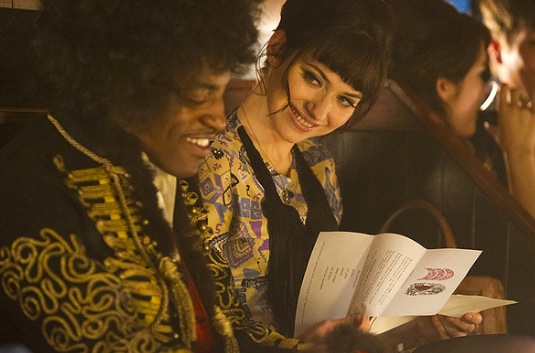
Jimi: All Is by My Side – A powerful look at the crucial years in an artist’s trajectory when the thrill of success begins to yield to the curse of fame
Screened at the 40th Seattle International Film Festival, André Benjamin channels Jimi Hendrix in this vibrant indie production, written and directed by John Ridley. As in many docu-fictions about famous performers, there is very little of Hendrix’ music in the film. This may be because the rights are so solidly bought and protected. Whatever the reason, the lack of music takes this movie one step further away from rock exploitation territory and that is a good thing. Ridley has to work to make the Hendrix image come across without blasting his legendary music to the audience.
This is not to say there is none of that great late 1960’s music in the film, the music is used to paint a vivid picture of the London rock scene of that period. At several points of the film Ridley’s work melds the standard rock riffs into a staccato abstract of the Hendrix style. Groups and members of groups such as The Animals, Rolling Stones and Beatles are shown realistically as people trying to make it big in a profession where everything is stacked against success. The backdrop of the outrageous fashions and the silly sci-fi spiritualism built firmly on a foundation of outright greed and avarice make the picture complete.
The film credits Linda Keith (great performance by Imogen Poots) with discovering Hendrix when he was booking minor venues in New York City. After several years of being a side-man in some big name bands, in 1966 he moved to New York City’s Greenwich Village. John Ridley’s screenplay and direction are critical in communication the chaos, confusion and rapid change of the rock music scene of the time. He does a great job showing how Keith saw him play and was able to see the genius. Many biopics simply show the subject’s rise to fame and rely on the audience to fill in the details. It is a credit to this film that we do not have to work to understand why Keith saw his style in the perspective of the current rulers of the rock scene, the top dogs of the British Invasion, and saw the beauty. There was nobody like him nor would there be anybody like him for the next two or three decades.
Hayley Atwell plays Kathy Etchingham, Hendrix’ lover during the period covered by the film. She met Jimi Hendrix on the day after his arrival in London in September, 1966, after he had finished his first gig. His life was never the same after that night, nor was the life of Linda Keith. Apparently not ready to leave Keith Richards yet, the film depicts her maintaining a nearly hysterical hold on to Hendrix.
Thanks in some part to excellent make-up and costume design; André Benjamin does a good job playing Hendrix. The artist is not portrayed as a stereotypical over-the-top drug addled rocker. Rather, he is a normal person who believes he has something to say and who is encouraged by a few people who believe in his message.
The time period treated by the film ends just before Jimi appears at the legendary Monterey Pop Music Festival in June of 1967. Although elated by the invitation to Monterey, his singles were not even making the charts in other countries. His biggest appearance to date was at the Spalding, Lincolnshire Barbeque ’67 concert where he appeared with the likes of Cream and Pink Floyd. Hendrix experimented with destroying equipment but the act was an artistic disaster. The debacle could have cancelled his entre to Monterey.
He is beginning to show the stress of dealing with multiple demands in pursuing his dream. It is implied that alcohol and drugs are taking their toll. Fighting a weakness to alcohol that dogged him until his death, his introduction to LSD and eventually the entire range of illicit drugs hurts him. The film gets very serious very fast as Hendrix’ fantasy world yields to a vicious assault on Kathy Etchingham.
He is the victim of racist police brutality on the one hand while being courted by marginally sincere black activists on the other. As he is becoming more famous, he is becoming more aware that there is no fantasy world in London, just as there was none in America. This not just a personal statement about the artist, it is an apt and unvarnished statement about his homeland, America, during the same period.*